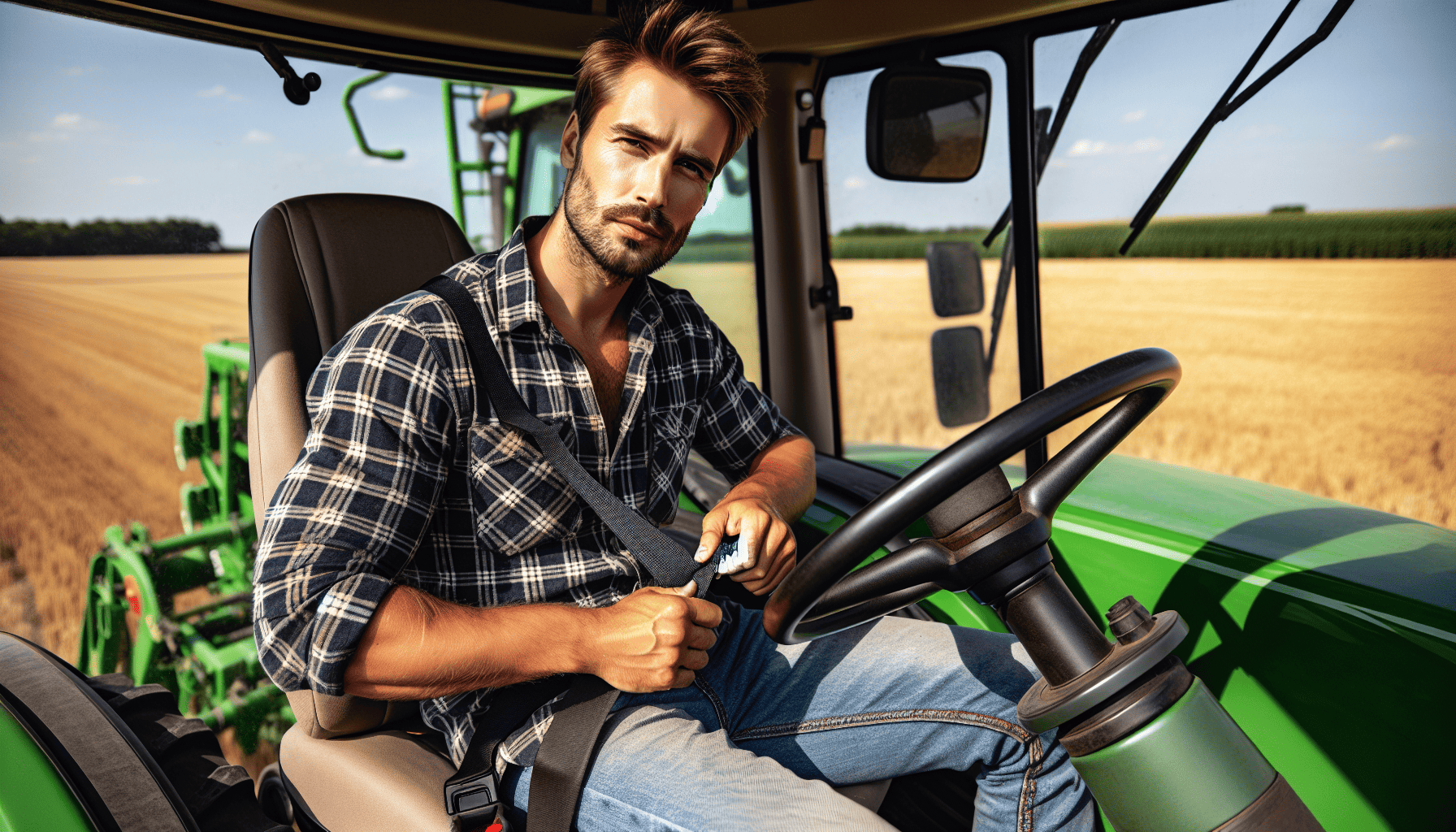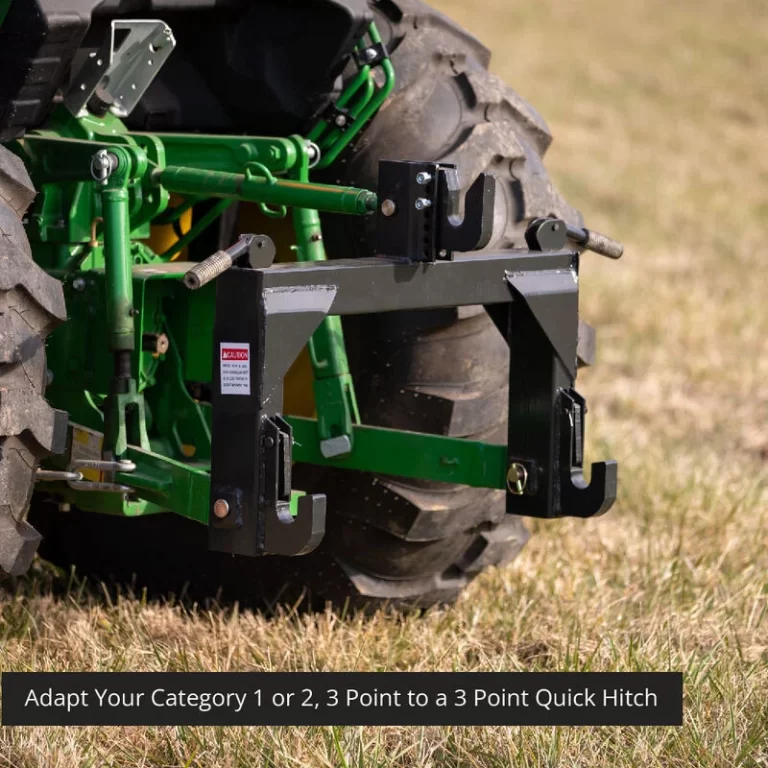Operating a Tractor and Essential Tractor Safety Tips

How can you enhance tractor safety and avoid common hazards? This practical guide addresses that concern head-on, equipping you with essential practices and checklists to ensure you’re never compromising on safety. From preparation to execution, learn to navigate the risks of tractor operation through a suite of preventative measures. Dive into topics including pre-operation checks, in-use precautions, and post-operational care to help keep you, and others, safe on the farm.
Key Takeaways
Prior to operating a tractor, one must familiarize with its controls, perform pre-start checks such as fluid levels and tire pressure, and adhere to safe mounting and starting procedures to prevent accidents and maintain the tractor’s condition.
Safe tractor operation includes practicing smooth gear transitions and braking, staying aware of the tractor’s wider turning radius, and utilizing additional front-end loader or attachment controls carefully, ensuring they’re correctly hitched and the PTO is engaged slowly.
Safety is paramount in tractor operation, requiring vigilance to prevent overturns, especially on slopes, adherence to proper maintenance schedules, wearing seat belts with ROPS, and continuous learning and training for handling the machinery responsibly.
Getting Started with a Tractor

Picture a typical day on a farm. The sun rises, and it’s time to get the tractor moving. But where do you start? Begin by learning about the controls. Most tractors will have a seat, steering wheel, clutch, brakes, gear selector, throttle, and a PTO (power take-off) control. These controls may vary in location and function, so always consult your tractor’s manual. Before you even turn the key, perform some pre-start checks. Check your fuel level, tire pressure, oil levels, and look for any obvious leaks or damage. This can help prevent tractor accidents and keep your farm tractor in top shape.
Safely mounting the tractor is of equal importance. Use the steps and handholds provided, position yourself comfortably in the tractor seat and adjust it if needed. Now you’re ready to start the tractor. The starting procedure may involve keys, choke, glow plugs, and more, so again, refer to your manual. Let the tractor run for several minutes before engaging the transmission to allow oil to circulate. This warm-up period contributes significantly to the tractor engine’s long-term health.
Moving the Tractor

Once you’re comfortably seated and the engine has warmed up, you can start moving the tractor. The first step is to depress the clutch fully and select a low gear to start. Slowly release the clutch while gradually applying throttle. Mastering this might require some practice, but it’s key for a smooth tractor operation.
Steering a tractor is not quite like steering a regular vehicle. Tractors often have a wider turning radius, so you need to be mindful of this. Here are some tips for steering a tractor:
As you gain speed, depress the clutch, shift to a higher gear, and then smoothly re-engage the clutch.
When it’s time to stop, depress the clutch, use the brakes, and select neutral gear.
Always set the parking brake when dismounting to prevent any unexpected movement.
Keep in mind, safely moving tractors requires practice, so take your time.
Using a Bucket Loader (If Equipped)
Picture this scenario: You’re on the farm, and you need to move a pile of dirt. This is where a front end loader comes in handy. If your tractor is equipped with a bucket loader, you’ll need to understand the controls for operating it. These controls, often a joystick or lever, are utilized to:
Raise the bucket
Lower the bucket
Tilt the bucket
Dump the bucket
When it comes to loading, follow these steps:
Approach the material slowly.
Tip the bucket forward slightly.
Raise the bucket while driving in.
Keep the bucket low while transporting loads for stability and visibility.
Adjust the load position in the bucket for greater balance.
To dump the load, elevate the bucket to the desired height, tilt it forward, and gradually open it for controlled material flow. As with anything, practice makes perfect. Start with easy tasks and gradually increase the difficulty as your skills improve.
Using Attachments
Tractors are versatile machines, thanks in large part to the variety of attachments available. Similar to the tractor itself, the safe usage of attachments necessitates understanding and practice. Before engaging the PTO, make sure the attachment is correctly hitched and the PTO shaft is connected. Engage the PTO slowly to prevent any sudden movements.
Here are some steps to follow when using tractor attachments:
Understand the specific controls for raising, lowering, or adjusting your implement.
Select a gear that aligns with the work you’re doing. Slower is often better for soil-engaging implements.
Always stay vigilant of obstacles and terrain, and maintain a safe distance from bystanders.
When you’re done, disengage the PTO, lower the implement, turn off the tractor, and properly unhitch the attachment. Remember, tractor attachments are tools, not toys. Handle them with care.
Other Essential Topics
Having covered the basics of tractor operation and attachment usage, we should explore a few other crucial topics. First, let’s talk about slope operation. Tractors are heavy machines, and they’re even heavier with a load. So, when you’re driving on hills, it’s crucial to exercise extreme caution. Drive straight up and down whenever possible, use lower gears, and avoid sudden turns.
As with any piece of machinery, maintenance is key to a long and useful life for your tractor. Follow your manual’s maintenance schedule for oil changes, filters, and the like. If you need to transport your tractor, ensure your trailer is adequate for the tractor’s weight and properly secure the tractor according to regulations.
Lastly, never stop learning. Consider hands-on instruction or seek resources from tractor associations or local dealers. Knowledge is power, especially when it comes to operating heavy machinery.
Understanding Tractor Safety

Tractor safety is not just about knowing how to operate the machinery. It’s about understanding the risks and taking the necessary precautions to mitigate these risks. Tractor safety encompasses operating the tractor safely to prevent fatal injuries and accidents, as well as ensuring occupational safety for those working with and around the machinery.
This means always being aware of your surroundings, maintaining a safe speed, and respecting the power of the machinery. It also means wearing the appropriate safety gear and ensuring the tractor is in a safe operating condition before use. Remember, a tractor is a tool, not a toy. Treat it with respect, and it will serve you well. By following these safety tips, you can ensure a secure working environment.
The Significance of Tractor Safety in Preventing Serious Injuries
The significance of tractor safety is beyond emphasis. Tractor accidents, including tractor related accidents, are the leading cause of death for farmers, with tractor overturns causing around 130 fatalities every year. These accidents occur across various regions in the US, particularly in the Midwest, Northeast, and South, and on farms engaged in crop production.
Not only do tractor overturns represent 50% of all farm worker fatalities each year, but 44% of all farm accidents involve tractor rollovers. Rollover accidents and collisions with motor vehicles are among the top causes of these fatalities, along with entanglement injuries from tractor equipment. Despite the experience level, one in ten tractor operators will face an overturn in their lifetime, emphasizing the importance of safety practices to mitigate risks.
Pre-Operation Safety Measures
Several pre-operation checks need to be performed before starting the tractor. Start by adjusting the tractor seat to ensure it fits the operator comfortably and implement vibration-absorbing features as needed. Inspect the tractor’s tires to ensure they are properly inflated, lug nuts are tight, and there is no significant tread wear.
Examine the engine area for loose or defective parts, such as a worn fan belt, and address these issues promptly. Check the fluid levels for indicators such as water in the oil, which may suggest serious issues such as a cracked head gasket.
Finally, inspect the operator’s platform area to ensure safe accessibility and check that the space around the seat is free of any debris or tools.
Checking the Power Takeoff Shaft and Hitch
During your pre-operation checks, the power takeoff (PTO) shaft, rear axle, and hitch should also be carefully inspected. The PTO is a crucial component of your tractor, providing power to the attachment or implement. Ensure that the PTO drive shaft operates properly under expected conditions, considering factors such as power requirement and lifespan to prevent mechanical failure.
When hitching equipment, follow these guidelines to ensure safety:
Follow the manufacturer’s instructions.
Avoid unsafe practices that could result in accidents.
Secure the drive shaft on the implement when not connected to the tractor to avoid damage during storage or transportation.
Remember, a well-maintained tractor is a safe tractor.
Ensuring Proper Fluid Levels
The necessity to maintain proper fluid levels is highly crucial. Regularly checking and maintaining the correct levels of hydraulic oil is essential for optimal tractor performance and safety.
To check the hydraulic fluid levels:
Park the tractor on level ground with implements lowered.
Start the engine and let it run for a few minutes.
Turn off the engine and allow it to settle.
Inspect the oil level in the sight glass.
Make sure the oil level is within the recommended range. If it is low, add hydraulic oil as needed.
If the oil level is below the lower mark, add hydraulic fluid using a clean funnel, wiping away debris before removing the cap to prevent contamination, and add the fluid incrementally to avoid overfilling. Maintaining proper oil and fuel levels is critical for the tractor engine’s consistent performance and to ensure safe operation in farming activities.
Safe Operation Practices
Upon completing the pre-operation checks and preparing to move, you should bear in mind some safety practices for operation. Tractors should be operated within the range of their designed capabilities to avoid accidents. This means driving at speeds that allow for safe control, especially near ditches and embankments, while reducing speed for turning and braking.
Utilizing engine braking downhill with a loaded tractor can effectively prevent rollovers. Maintaining steady and gentle brake application is crucial for stability, especially with heavy loads. And remember, tractors are not intended for tasks such as herding cattle, which can result in accidents from uneven terrain and excessive speed.
Last but not least, ensure visibility by cleaning dirty cab windows for safe tractor operation.
Utilizing Seat Belts and Rollover Protective Structure
The seat belt, particularly when used alongside a Rollover Protective Structure (ROPS), is one of the tractor’s most essential safety features. A ROPS, when used with a seatbelt, are 99% effective in preventing serious injury or death in tractor overturns, providing a ‘protective zone’ for the operator.
Operators are required to wear seat belts with ROPS to ensure they remain within the protective zone during an overturn. It’s important to note that seat belts should not be used on tractors without ROPS. ROPS compliant cabins are mandatory for tractors over 560kg to prevent fatalities during rollovers, emphasizing the importance of such structures in accident prevention.
Without ROPS, operators of antique tractors or those manufactured without such structures face increased risks during overturns.
Handling Tractor Attachments with Care
Handling the attachments with care is as important as operating the tractor itself. When using front-end loaders, keep the bucket low while transporting loads to maintain a stable center of gravity and reduce the risk of tipping. Maintain sufficient rear ballast when carrying heavy loads, particularly with a front-end loader, to avoid making the rear too light and destabilizing the tractor.
Widening the spacing of the tractor’s wheels can significantly increase its baseline stability, reducing the potential for side overturns during operation. And always provide a designated support location to secure the drive shaft on the implement when not connected to the tractor to avoid damage during storage or transportation. Remember, safety first when handling tractor attachments!
Navigating Tractors on Challenging Terrain
Despite being designed to handle tough terrain, tractors are not impervious to the associated dangers. Tractors are more susceptible to rollovers compared to other vehicles due to their high center of gravity. To avoid tractor overturns on slopes caused by speed or operator error, it’s advisable to drive tractors up and down slopes rather than across, slow down for turns, and maintain caution.
When navigating steep areas, using lower gears, reducing speed, and keeping loads low and balanced can help maintain tractor stability. In adverse weather conditions such as fog, rain, snow, or ice, reducing speed and cautiously handling the tractor can prevent accidents by improving vehicle control and visibility. Driving around ditches and steep slopes and avoiding sharp turns, overloading, and operating in bad weather can minimize the risk of tractor accidents.
Controlling Speed on Steep Slopes
Navigating steep slopes can pose a particular challenge. When driving on steep slopes, it’s crucial to keep the tractor in low gear to maintain control. Maintaining an appropriate speed on steep slopes is essential to prevent the tractor from losing stability and rolling over.
Sudden direction changes or abrupt stops on steep slopes increase the risk of tractor rollovers and should be avoided. Adhering to these practices minimizes the potential for rollovers, contributing to safer tractor operation on challenging terrain.
Managing Heavy Loads and Wheel Weights
Regarding the management of heavy loads and wheel weights, there are a few essential points to keep in mind. Securing loads to the tractor’s drawbar and using front weights can greatly enhance stability and lower the risk of rear overturns, especially during heavy lifting operations involving rear wheels. To further improve stability, it’s crucial to drive the tractor forward with caution.
Keeping the heavy end uphill is safer when navigating sloped terrain with a heavy load, and may require backing down hills with a loaded bucket to prevent instability and accidents. It’s like taking a cautious step with your left foot on a slippery surface.
Widening the spacing of the tractor’s wheels can significantly increase its baseline stability, thereby reducing the potential for side overturns during operation.
To prevent injury from falling objects, it is imperative to utilize the appropriate lifting attachment for the task and ensure that the tractor is equipped with a falling object protective structure (FOPS).
Post-Operation Procedures
Similar to the pre-operation steps, there are crucial post-operation procedures to adhere to. Allow the tractor engine to cool down at a fast idle before shutting off to ensure the engine parts, such as valves and pistons, cool down evenly. A diesel tractor should be idled for a few minutes after working to help engine parts to cool down evenly and to identify any potential issues through listening.
Refilling the fuel tank after the tractor has cooled helps to prevent condensation inside the fuel tank and keeps the tractor ready for the next operation. Upon completing operation, all hydraulic lifts should be lowered to the ground to prevent accidents and maintain tractor stability. When leaving a tractor-loader unattended, ensure the bucket is lowered to the ground as part of post-operation procedures.
Special Considerations for Older Tractors
While older tractors carry a certain charm, they present their unique set of challenges. Older tractors often lack modern safety features and are less reliable, increasing the risk of accidents. Side and rear overturns are common causes of death in accidents involving older tractors, and retrofitting with professionally installed ROPS can prevent these.
Owners of old tractors should recognize that these vehicles are less stable and more accident-prone, necessitating extra precautions. Regular and thorough checks and replacements of the following are essential due to the age and wear of older tractors:
oils
grease points
filters
rubber products
Remember, an old tractor isn’t necessarily a dangerous one, but it does require careful handling.
Training and Education for Tractor Operators
Becoming proficient in operating a tractor isn’t an overnight process. Comprehensive training and a thorough understanding of the tractor’s user manual are fundamental for the safe operation of tractors. In certain regions, such as South Africa, there are legal mandates requiring tractor operators to undergo training and periodic refreshers to ensure safety and regulatory compliance.
Trained tractor operators:
Enhance their job performance
Are in high demand
Help reduce unemployment in the agricultural sector
Receive certification through recognized training programs
Support compliance with service policies and export regulations
Advancements in agricultural machinery technology necessitate operators to receive basic training to utilize the equipment efficiently and effectively. Remember, knowledge is power.
Protecting Against Health Risks
Health risks linked with tractor operation extend beyond just the risk of accidents. Exposure to noise from agricultural equipment, like tractors, can cause permanent and irreversible hearing loss. Tractor noise can result in temporary hearing reduction or tinnitus, signaling the noise level is dangerously high.
Wearing personal protective equipment such as earmuffs or earplugs is essential when operating noisy machinery like tractors. The earmuff style of hearing protection provides optimal noise reduction, while properly inserted foam earplugs are also effective. It’s advised to mark areas where there is a risk of excessive noise with ‘HIGH NOISE ZONE’ signs and to restrict the duration of exposure to loud noises.
Hearing protection devices with a high Noise Reduction Rating (NRR) effectively protect against the noise from tractor engines. In addition to hearing protection, wearing comfortable clothing and boots, and securing oneself with a seatbelt if available, are important for overall safety.
Summary
In conclusion, operating a tractor safely is a multifaceted process that requires knowledge, practice, and vigilance. From understanding the controls to navigating challenging terrains, each step plays a crucial role in ensuring your safety and the longevity of the machinery. So, whether you’re a seasoned farmer or a novice operator, remember to always treat the tractor with respect, adhere to safety measures, and never stop learning. Because at the end of the day, safety is no accident.
Frequently Asked Questions
What are the safety precautions for tractors?
When operating a tractor, always fasten seat belts securely, avoid operating near ditches or steep slopes, and disengage the PTO before getting off the tractor. Mount and dismount on the left side and use approved ROPS and seatbelts for added safety.
What are the four categories of tractor hazards?
The four categories of tractor hazards are mechanical, chemical, physical, and environmental. These hazards encompass a wide range of potential risks that should be carefully managed.
What is the most common type of tractor accidents?
The most common type of tractor accidents is rollovers, as tractors are top-heavy and more prone to this type of incident.
Is operating a tractor hard?
Operating a tractor is similar in difficulty to driving any vehicle, with some aspects being simpler and others more complex. The difficulty depends on the specific tractor and one’s definition of “hard.”
Why is it important to perform pre-start checks before operating a tractor?
Performing pre-start checks is important before operating a tractor because it helps identify any potential issues with the tractor and ensures it’s in a safe operating condition.




